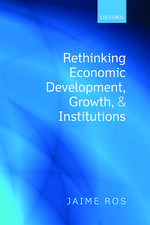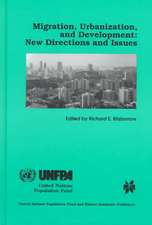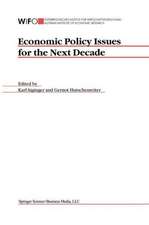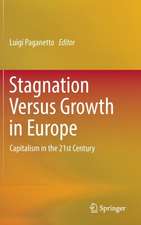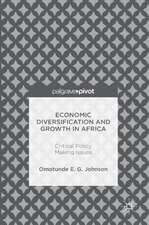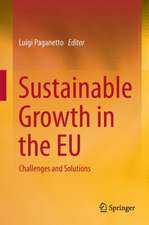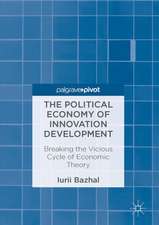Biased Technical Change and Economic Conservation Laws: Research Monographs in Japan-U.S. Business and Economics, cartea 9
Autor Ryuzo Satoen Limba Engleză Hardback – feb 2006
In this book, application of this general approach to study of biased technical change is developed and new empirical results presented for both macroeconomies and microeconomic firms.
| Toate formatele și edițiile | Preț | Express |
|---|---|---|
| Paperback (1) | 887.55 lei 6-8 săpt. | |
| Springer Us – 19 noi 2010 | 887.55 lei 6-8 săpt. | |
| Hardback (1) | 644.49 lei 6-8 săpt. | |
| Springer Us – feb 2006 | 644.49 lei 6-8 săpt. |
Preț: 644.49 lei
Preț vechi: 758.23 lei
-15% Nou
Puncte Express: 967
Preț estimativ în valută:
123.33€ • 131.88$ • 102.82£
123.33€ • 131.88$ • 102.82£
Carte tipărită la comandă
Livrare economică 18 aprilie-02 mai
Preluare comenzi: 021 569.72.76
Specificații
ISBN-13: 9780387260556
ISBN-10: 0387260552
Pagini: 240
Ilustrații: XII, 230 p.
Dimensiuni: 156 x 234 x 19 mm
Greutate: 0.53 kg
Ediția:2006
Editura: Springer Us
Colecția Springer
Seria Research Monographs in Japan-U.S. Business and Economics
Locul publicării:New York, NY, United States
ISBN-10: 0387260552
Pagini: 240
Ilustrații: XII, 230 p.
Dimensiuni: 156 x 234 x 19 mm
Greutate: 0.53 kg
Ediția:2006
Editura: Springer Us
Colecția Springer
Seria Research Monographs in Japan-U.S. Business and Economics
Locul publicării:New York, NY, United States
Public țintă
ResearchCuprins
An Overview.- An Overview.- Biased Technical Change.- The Stability of the Solow-Swan Model with Biased Technical Change.- A Model of Optimal Economic Growth with Endogenous Bias.- A Three Sector Model of Endogenous Hicksian Bias.- Estimation of Biased Technical Progress.- A Note on Modelling Endogenous Growth.- Technical Change and International Competition.- Economic Conservation Laws.- Optimal Economic Growth: Test of Income/Wealth Conservation Laws in OECD Countries.- Economic Conservation Laws as Indices of Corporate Performance.- Empirical Tests of the Total Value Conservation Law of the Firm.- Hartwick’s Rule and Economic Conservation Laws.
Notă biografică
Ryuzo Sato is the C.V. Starr Professor of Economics and the director of the Center for Japan-U.S. Business and Economic Studies at the New York University Stern School of Business. In his current position, Dr. Sato teaches an MBA course in the comparative analysis of the Japanese and United States economies, an Undergraduate course ISP (International Studies Project,) and a Ph.D. level course on economic growth and technological change.
Dr. Sato has been with NYU Stern for more than 15 years. His primary areas of research interest are: economic growth, technical change, differential games, international business and United States-Japan relations.
Dr. Sato has been with NYU Stern for more than 15 years. His primary areas of research interest are: economic growth, technical change, differential games, international business and United States-Japan relations.
Textul de pe ultima copertă
The principal aim of BIASED TECHNICAL CHANGE AND ECONOMIC CONSERVATION LAWS is twofold: to reveal the new economic significance of the old concept of biased technical change and the current application of the new concept of economic conservation laws.
Although terms such as "labor saving" and "capital saving" fall under the category of biased technical change, the first of these topics, no model exists in which biased technical change gives rise endogenously to technical progress. A special feature of this book is its thorough investigation and analysis of these issues, which go far beyond existing studies in this area.
The concept of economic conservation laws dates back to Ramsey’s classic study of 1928. This book primarily makes use of Lie groups to shed new light on the analysis of economic conservation laws. Economic conservation laws are not simply abstract concepts; this book shows that they are tools of empirical analysis that can be applied to such topics as analyses of macro performance and corporate efficiency.
Although terms such as "labor saving" and "capital saving" fall under the category of biased technical change, the first of these topics, no model exists in which biased technical change gives rise endogenously to technical progress. A special feature of this book is its thorough investigation and analysis of these issues, which go far beyond existing studies in this area.
The concept of economic conservation laws dates back to Ramsey’s classic study of 1928. This book primarily makes use of Lie groups to shed new light on the analysis of economic conservation laws. Economic conservation laws are not simply abstract concepts; this book shows that they are tools of empirical analysis that can be applied to such topics as analyses of macro performance and corporate efficiency.
Caracteristici
Concentrate on the labor productivity of firms Examines the difference or bias in the productivity growth of two inputs; labor productivity and productivity of capital Includes supplementary material: sn.pub/extras










